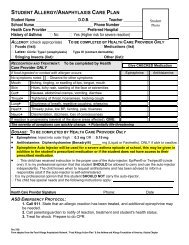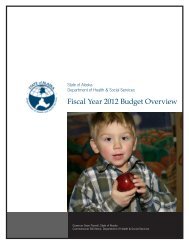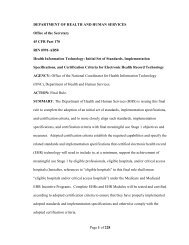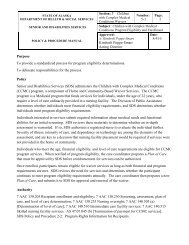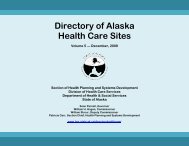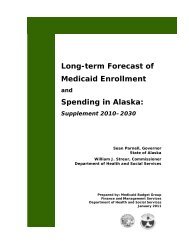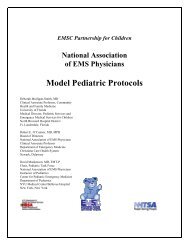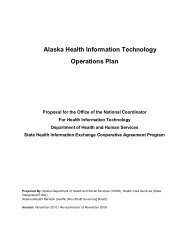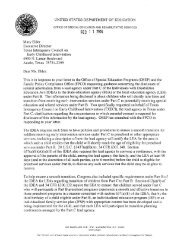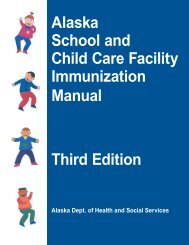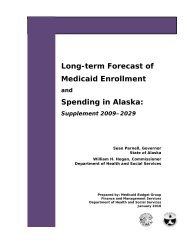SUMMER UPDATE 2010 - Alaska Department of Health and Social ...
SUMMER UPDATE 2010 - Alaska Department of Health and Social ...
SUMMER UPDATE 2010 - Alaska Department of Health and Social ...
You also want an ePaper? Increase the reach of your titles
YUMPU automatically turns print PDFs into web optimized ePapers that Google loves.
AlASkA DEPARTMENT oF HEAlTH & SociAl SERvicES<br />
OCS exp<strong>and</strong>s Bethel <strong>of</strong>fice ..... 1<br />
Medicaid Management<br />
Information System update ..... 1<br />
<strong>Health</strong> Information Technology<br />
update ..................................... 2<br />
Childhood obesity.................... 2<br />
Transitional Age Youth ............ 2<br />
Governor’s message .............. 3<br />
Commissioner’s message ....... 3<br />
Leadership transitions ............. 3<br />
<strong>Health</strong> Care Commission in<br />
statute .................................... 3<br />
Low Medicaid error rate........... 3<br />
Johnson Youth Center ............ 4<br />
Senior & Disabilities waiver<br />
update ..................................... 4<br />
<strong>SUMMER</strong> <strong>UPDATE</strong> <strong>2010</strong><br />
Sean Parnell<br />
Governor<br />
Bill Hogan<br />
Commissioner<br />
Promoting <strong>and</strong> protecting the health <strong>and</strong> well-being <strong>of</strong> <strong>Alaska</strong>ns<br />
v o l u m e 6 N u m b e r 2<br />
Children’s Services improvements under way<br />
OCS to hire new positions in Bethel area; establishes new ‘Western’ region<br />
Quyana is the way one Office <strong>of</strong><br />
Children’s Services employee<br />
responded to recent systems<br />
improvements in the Bethel<br />
<strong>of</strong>fice where she works.<br />
Sharon Lindley used the Yup’ik word for<br />
“thank you” in a recent note to Tim Bolles,<br />
Regional Manager.<br />
“Quyana for the new computers, the wireless<br />
connection, etc.,” Lindley wrote. “It’s wonderful<br />
to work with a faster tool. Gone is the slowness<br />
<strong>of</strong> the computer, <strong>and</strong> the little quirks associated<br />
with the old set-up.”<br />
Speeding up connectivity <strong>and</strong> eliminating<br />
some <strong>of</strong> those pesky computer quirks that made<br />
doing business difficult were among the goals<br />
<strong>of</strong> a wide-ranging <strong>and</strong> multifaceted systems<br />
improvement plan in the area.<br />
In addition to purchasing more b<strong>and</strong>width to<br />
improve Internet access for that <strong>of</strong>fice, the plan<br />
includes allocating <strong>and</strong> recruiting for additional<br />
positions for Office <strong>of</strong> Children’s Services<br />
workers in the area.<br />
Also, the Office <strong>of</strong> Children’s Services will exp<strong>and</strong><br />
from its current four to five service regions within the<br />
state. The newly proposed region will be named the<br />
Table <strong>of</strong> Contents<br />
Mental <strong>Health</strong> access .............. 4<br />
Ketchikan Pioneer Home fun... 4<br />
DHSS news briefs ................... 5<br />
DHSS ‘STARS’ ....................... 5<br />
OCS Program Improvement .... 6<br />
OCS disproportionality ............ 6<br />
Tobacco sales to youth ........... 6<br />
FAS decreases........................ 6<br />
Workforce Development ......... 7<br />
EMS awards ............................ 7<br />
ISAs help youth stay home ...... 8<br />
Adoption incentive funds ......... 8<br />
Pioneer Homes news briefs .... 8<br />
Bethel is located in southwestern <strong>Alaska</strong>, 40 miles from the mouth <strong>of</strong> the Kuskokwim River,<br />
400 air miles west <strong>of</strong> Anchorage. Flight time by jet from Anchorage to Bethel is one hour,<br />
<strong>and</strong> there are many daily flights. Bethel has experienced tremendous population growth<br />
over the past two decades. The population in 1980 was 3,576 <strong>and</strong> in 1990 was 4,674.<br />
Currently Bethel’s population is approximately 6,400.<br />
“Western Region” <strong>and</strong> will include Bethel, Aniak <strong>and</strong><br />
St. Marys. Currently those communities are part <strong>of</strong> the<br />
Southcentral Region, which is headquartered in Wasilla.<br />
medicaid management Information System:<br />
System design complete<br />
Significant progress continues on the project to<br />
implement <strong>Alaska</strong> Medicaid <strong>Health</strong> Enterprise,<br />
the state’s new Medicaid Management Information<br />
System (MMIS).<br />
Final design <strong>of</strong> the new system was completed<br />
<strong>and</strong> approved in March <strong>2010</strong>. Completion <strong>of</strong> the<br />
system design phase marks a major milestone <strong>and</strong><br />
will allow coding <strong>of</strong> <strong>Alaska</strong>-specific requirements to<br />
begin.<br />
The project’s primary goal continues to be to<br />
implement a high-quality MMIS that will accurately<br />
<strong>and</strong> efficiently process payments for <strong>Alaska</strong>’s medical<br />
assistance providers while meeting the needs <strong>of</strong> the<br />
members enrolled in the programs.<br />
“Our focus remains on quality as we develop an<br />
infrastructure that will enable the state to effectively<br />
File photo<br />
The state’s Citizen’s Review Panel<br />
advocated for a separate, western service<br />
region in its 2008 <strong>and</strong> 2009 annual reports to<br />
the Legislature. Beginning in fall 2009, a task<br />
force was formed to improve service delivery<br />
<strong>of</strong> child protective services to the western part<br />
<strong>of</strong> <strong>Alaska</strong>.<br />
Task force members were drawn from<br />
the <strong>Alaska</strong> Court System, Legislature,<br />
DHSS <strong>and</strong> other agencies. Representatives<br />
included Judge Douglas Blankenship, Rep.<br />
Bob Herron, Rep. Nancy Dahlstrom, Rep.<br />
Wes Keller, Sen. Lyman H<strong>of</strong>fman, Sen. John<br />
Coghill, DHSS Commissioner Bill Hogan <strong>and</strong><br />
OCS Director Tammy S<strong>and</strong>oval.<br />
Governor Sean Parnell <strong>and</strong> key members<br />
<strong>of</strong> the Legislature added their support at the<br />
start <strong>of</strong> the legislative session, agreeing this<br />
would become a state priority in <strong>2010</strong>.<br />
“We must be more responsive to the needs<br />
<strong>of</strong> our most vulnerable kids <strong>and</strong> families <strong>and</strong><br />
to our many community partners,” DHSS<br />
Commissioner Hogan said. “We strongly<br />
believe these changes will make a big difference in the<br />
way we do business in Western <strong>Alaska</strong>.”<br />
serve our citizens for years to come,” said William<br />
Streur, Deputy Commissioner for Medicaid <strong>and</strong><br />
<strong>Health</strong> Care Policy.<br />
<strong>Alaska</strong> Medicaid <strong>Health</strong> Enterprise will be<br />
compliant with the new national electronic transaction<br />
st<strong>and</strong>ards, known as X12 Version 5010 (5010)<br />
<strong>and</strong> NCPDP Version D.0 (D.0). The technical <strong>and</strong><br />
business changes <strong>of</strong> transitioning to the use <strong>of</strong> 5010<br />
<strong>and</strong> D.0 are significant. The Design Development<br />
<strong>and</strong> Implementation (DDI) MMIS replacement<br />
project team is adding these requirements into the<br />
existing implementation <strong>and</strong> will make every effort<br />
to minimize the need for multiple testing cycles by<br />
health care providers.<br />
For more information about <strong>Alaska</strong> Medicaid <strong>Health</strong><br />
Enterprise, go to www.alaskamedicaid.info.
Ki<br />
K ds . . . Fa<br />
<strong>Health</strong><br />
Information<br />
Technology<br />
update<br />
The Centers for Medicare <strong>and</strong><br />
Medicaid Services (CMS) has<br />
awarded the <strong>Department</strong> <strong>of</strong> <strong>Health</strong><br />
<strong>and</strong> <strong>Social</strong> Services $1 million in<br />
planning dollars to develop the<br />
State Medicaid <strong>Health</strong> Information<br />
Technology Plan (SMHP). The<br />
SMHP will define how health<br />
information is shared between the<br />
state <strong>and</strong> the state health information<br />
exchange.<br />
The American Recovery <strong>and</strong><br />
Reinvestment Act appropriated<br />
funds to incentivize qualified<br />
Medicare <strong>and</strong> Medicaid providers<br />
to “Adopt, Implement, Upgrade<br />
<strong>and</strong> Meaningfully Use EHR’s” as<br />
written in the federal HITECH bill.<br />
The SMHP will also define how<br />
the state will identify qualified<br />
Medicaid providers, verify<br />
meaningful use <strong>and</strong> administer the<br />
incentive payments.<br />
The SMHP must be approved<br />
by CMS prior to payment <strong>of</strong> any<br />
EHR incentives. The state has<br />
awarded a contract to Fox systems<br />
to provide technical assistance in<br />
the development <strong>of</strong> the SMHP.<br />
Development <strong>and</strong> approval <strong>of</strong><br />
the SMHP is expected to take<br />
approximately 12 months. The<br />
state hopes to begin making EHR<br />
incentive payments in the summer<br />
<strong>of</strong> 2011.<br />
<strong>Health</strong> Information<br />
exchange (HIe)<br />
DHSS has received a grant<br />
from the Office <strong>of</strong> the National<br />
Coordinator for <strong>Health</strong> Information<br />
Technology (ONC) to assist in the<br />
development <strong>of</strong> appropriate, secure<br />
exchange <strong>of</strong> health information<br />
between health care providers <strong>and</strong><br />
payers. The state has awarded a<br />
contract to <strong>Alaska</strong> e<strong>Health</strong> Network<br />
(AeHN) to procure <strong>and</strong> manage the<br />
HIE.<br />
The board <strong>and</strong> staff <strong>of</strong> <strong>Alaska</strong><br />
e<strong>Health</strong> Network will work with the<br />
state, providers <strong>and</strong> the public to<br />
develop the necessary governance,<br />
policies, technical services,<br />
business operations, <strong>and</strong> financing<br />
mechanisms for the HIE.<br />
For more information, go to: hss.<br />
state.ak.us/hit/.<br />
2<br />
FF milies . . . Community<br />
<strong>Health</strong> care leaders from the <strong>Alaska</strong><br />
<strong>Department</strong> <strong>of</strong> <strong>Health</strong> <strong>and</strong> <strong>Social</strong> Services<br />
met with community partners this spring to<br />
work together to reduce childhood obesity<br />
across the state.<br />
The partnership, called <strong>Alaska</strong>ns Taking on Childhood<br />
Obesity (ATCO), had its first meeting in early May.<br />
Commissioners <strong>and</strong> other directors from the departments<br />
<strong>of</strong> <strong>Health</strong> <strong>and</strong> <strong>Social</strong> Services <strong>and</strong> Education <strong>and</strong> Early<br />
Development were invited, along with leaders from local<br />
school districts <strong>and</strong> boards, <strong>and</strong> a doctor working in tribal<br />
health care.<br />
The group considered a number <strong>of</strong> strategies to combat<br />
childhood obesity through school-based, child-care <strong>and</strong><br />
community efforts, said Andrea Fenaughty, the group’s<br />
facilitator.<br />
Fenaughty, an epidemiologist with <strong>Alaska</strong>’s Division<br />
<strong>of</strong> Public <strong>Health</strong>, said the timing is right to focus efforts on<br />
targeting childhood obesity. Estimates show that between 27<br />
percent <strong>and</strong> 40 percent <strong>of</strong> <strong>Alaska</strong>’s children are overweight<br />
or obese, she said. These extra pounds come at a heavy price.<br />
Obese children have a higher risk <strong>of</strong> developing chronic<br />
www.HSS.STATE.AK.US<br />
t . . .<br />
State, partners join to combat<br />
childhood obesity throughout state<br />
Youth <strong>and</strong> young adults with behavioral health disorders are at a high risk<br />
for poor outcomes as they transition to adulthood.<br />
<strong>Alaska</strong>’s <strong>Health</strong> <strong>and</strong> <strong>Social</strong> Services fiscal year 2011 budget includes<br />
$400,000 to implement the nationally recognized TIP (Transition to<br />
Independence Process) that teaches self-advocacy <strong>and</strong> relationship skills, <strong>and</strong><br />
builds a support network for<br />
youth. TIP pilot projects will<br />
help youth <strong>and</strong> young adults<br />
become productive adults.<br />
“Youth become homeless<br />
<strong>and</strong> struggle to meet their basic<br />
needs,” said Brita Bishop,<br />
coordinator <strong>of</strong> the Bring The<br />
Kids Home initiative for<br />
the <strong>Alaska</strong> <strong>Department</strong> <strong>of</strong><br />
<strong>Health</strong> <strong>and</strong> <strong>Social</strong> Services.<br />
“Many have been in mental<br />
health residential treatment,<br />
foster care or juvenile justice<br />
settings,” she said.<br />
The 2005 <strong>Alaska</strong> Foster<br />
Care Alumni Study found<br />
that nearly four in 10 alumni<br />
reported being homeless since<br />
leaving care. Covenant House<br />
<strong>Alaska</strong> reports that 80 percent<br />
<strong>of</strong> their 2009 intakes were<br />
mental health beneficiaries, <strong>and</strong> 34 percent <strong>of</strong> those seeking services at their<br />
Crisis Center have a history <strong>of</strong> residential psychiatric treatment.<br />
For more information go to: tip.fmhi.usf.edu/ or contact Brita Bishop,<br />
brita.bishop@alaska.gov.<br />
diseases, such as type 2 diabetes, high blood pressure <strong>and</strong><br />
cholesterol, <strong>and</strong> certain types <strong>of</strong> cancer, Fenaughty said.<br />
Medical complications from obesity cost the state’s<br />
economy about $477 million each year.<br />
“The complications <strong>of</strong> being overweight or obese are now<br />
the most worrisome causes <strong>of</strong> avoidable disease <strong>and</strong> premature<br />
death for <strong>Alaska</strong>ns,” said Dr. Ward Hurlburt, <strong>Alaska</strong>’s Chief<br />
Medical Officer. “We see poor eating <strong>and</strong> activity habits<br />
develop in early childhood, <strong>and</strong> we need to turn that around<br />
now, <strong>and</strong> for the rest <strong>of</strong> their lifetimes. Improving the health<br />
<strong>of</strong> our preschool through 12th-grade children will help prevent<br />
them from becoming the first generation to have a shorter life<br />
expectancy than their parents had.”<br />
Failing to reduce childhood obesity could lead to longterm<br />
health problems for affected children. Many overweight<br />
children remain overweight later in life. About two out <strong>of</strong><br />
every three adults in <strong>Alaska</strong> are above a healthy weight,<br />
Fenaughty said.<br />
See the 2009 Childhood Obesity in <strong>Alaska</strong> report at: www.<br />
hss.state.ak.us/dph/chronic/obesity/pubs/Childhood_Obesity.<br />
pdf. For a national perspective, go to: www.cdc.gov/obesity/<br />
childhood.<br />
Youth with behavior disorders need help to<br />
become productive, adjusted adults<br />
In the words <strong>of</strong> one<br />
young <strong>Alaska</strong>n<br />
“The transition to adulthood is<br />
challenging, scary, <strong>and</strong> emotional. …<br />
being in the system adds a lot <strong>of</strong> additional<br />
obstacles. … I was pressured to go to<br />
college so that I would have a place to<br />
stay <strong>and</strong> some sort <strong>of</strong> direction. Once<br />
my semesters at college were through, it<br />
became stressful trying to find a place to<br />
live, get financially stable, <strong>and</strong> obtain a<br />
plan for my future. I could not just move<br />
back with my parents like many people do<br />
because I don’t have any. When you are in<br />
the system it feels like you have a ton <strong>of</strong><br />
people around you: judges, therapists, case<br />
workers, etc., but once you leave the system<br />
it seems like most or all <strong>of</strong> your support<br />
network is gone, <strong>and</strong> you have to figure<br />
everything out on your own. … It’s really<br />
easy to give up, but if I weren’t so stubborn<br />
<strong>and</strong> resilient I just may have. If I could do<br />
things differently, I would develop a real<br />
plan for my future <strong>and</strong> engage in life skills<br />
classes <strong>and</strong> seek out resources early on.”<br />
Summer <strong>2010</strong> DHSS Update<br />
Stock photo
etirements bring leadership<br />
changes to two divisions<br />
barbara Henjum will replace Steve McComb,<br />
who retired May 28, as director <strong>of</strong> the Division<br />
<strong>of</strong> Juvenile Justice. Henjum <strong>and</strong> McComb<br />
worked together as co-directors throughout<br />
May to ensure a seamless transition.<br />
Henjum has an extensive background in juvenile justice.<br />
She first joined DJJ in 1983 as a youth<br />
counselor at McLaughlin Youth Center<br />
in Anchorage. Prior to moving to <strong>Alaska</strong>,<br />
Henjum worked at Hennepin County<br />
Juvenile Center in Minneapolis. For<br />
the past seven years, she served as a<br />
Superintendent III <strong>of</strong> MYC, where<br />
Henjum<br />
her duties included administration <strong>and</strong><br />
supervision <strong>of</strong> the 160-bed detention<br />
<strong>and</strong> correctional facility, as well as community detention <strong>and</strong><br />
aftercare services. In addition to her MYC duties, she also<br />
supervised the Kenai <strong>and</strong> Palmer facilities.<br />
Henjum holds a master <strong>of</strong> science degree in counseling<br />
psychology from the University <strong>of</strong> <strong>Alaska</strong> Anchorage <strong>and</strong><br />
a bachelor <strong>of</strong> arts in psychology from St. Olaf College in<br />
Minnesota.<br />
Among her many pr<strong>of</strong>essional activities, she is currently a<br />
member <strong>of</strong> the Anchorage Domestic Violence Fatality Review<br />
Team, Office <strong>of</strong> Victim’s Rights. She is also active with the<br />
<strong>Health</strong> Care<br />
Commission<br />
now in statute A national review <strong>of</strong> how<br />
accurately providers bill<br />
Senate Bill 172 has established the<br />
<strong>Alaska</strong> <strong>Health</strong> Care Commission<br />
in statute: AS 18.09.010. The<br />
commission was created in 2008.<br />
The statute exp<strong>and</strong>s the commission’s<br />
membership from 10 to 14. The<br />
11 voting members appointed by the<br />
Governor include the DHSS medical<br />
director; representatives from the<br />
tribal health community; the statewide<br />
chamber <strong>of</strong> commerce; the <strong>Alaska</strong> State<br />
Hospital <strong>and</strong> Nursing Home Association<br />
(ASHNHA); the <strong>Alaska</strong> Mental <strong>Health</strong><br />
Trust Authority; the health insurance<br />
industry in <strong>Alaska</strong>; community health<br />
centers; the federal Veterans Affairs<br />
health care industry; an active, licensed<br />
health care provider not affiliated with<br />
ASHNHA; a health care consumer, with<br />
no affiliation to the health care industry;<br />
<strong>and</strong> a licensed primary care physician<br />
with an active practice <strong>of</strong> family medicine,<br />
primary care internal medicine or<br />
pediatric medicine.<br />
The commission serves as the<br />
state health planning <strong>and</strong> coordinating<br />
body, providing recommendations to<br />
the Governor <strong>and</strong> the Legislature on a<br />
comprehensive statewide health care<br />
policy <strong>and</strong> on strategies for improving<br />
the health <strong>of</strong> <strong>Alaska</strong>ns.<br />
For more information, go to: hss.state.<br />
ak.us/healthcommission.<br />
<strong>Alaska</strong> Workforce Investment Board Youth Council. Since<br />
2008, she has served as vice president <strong>of</strong> the National Juvenile<br />
Detention Association Western Region. In 2002, she was<br />
named <strong>Alaska</strong> Mental <strong>Health</strong> Pr<strong>of</strong>essional <strong>of</strong> the Year <strong>and</strong><br />
received the Carolyn Frichette Award at the Children’s Mental<br />
<strong>Health</strong> Conference in Anchorage.<br />
Interim appointment for Senior <strong>and</strong><br />
Disabilities Services division<br />
Senior <strong>and</strong> Disabilities Services Division Director<br />
Rebecca Hilgendorf retired this past spring after 27 years <strong>of</strong><br />
service to the state <strong>of</strong> <strong>Alaska</strong>. Kimberli Poppe-Smart, director<br />
<strong>of</strong> <strong>Health</strong> Care Services, was named<br />
acting director during the search for a<br />
permanent replacement.<br />
Last year, Hilgendorf <strong>and</strong> Poppe-<br />
Smart worked together to respond to a<br />
review <strong>of</strong> SDS’ Medicaid waiver program<br />
by the federal Centers for Medicare <strong>and</strong><br />
Medicaid Services. SDS began many<br />
Poppe-Smart<br />
changes to better reflect the division’s<br />
philosophy <strong>of</strong> client-centered care <strong>and</strong><br />
commitment to timely, high-quality services. Top division<br />
issues include the ongoing response to the CMS review <strong>and</strong><br />
the needs <strong>of</strong> <strong>Alaska</strong>’s fast-growing senior population.<br />
<strong>Alaska</strong>’s low medicaid billing<br />
error rate draws kudos<br />
Medicaid found <strong>Alaska</strong> had an error<br />
rate <strong>of</strong> less than 1 percent, lowest <strong>of</strong> 17<br />
states in federal fiscal year 2008.<br />
The Payment Error Rate<br />
Measurement<br />
(PERM) review<br />
examines states’<br />
Medicaid billing<br />
procedures<br />
<strong>and</strong> provider<br />
compliance.<br />
Groups <strong>of</strong> states<br />
are measured<br />
every three years<br />
in the staggered<br />
review. The<br />
round <strong>of</strong> the<br />
review that<br />
included <strong>Alaska</strong><br />
<strong>and</strong> 16 other<br />
states looked at<br />
Medicaid claims<br />
25%<br />
20%<br />
15%<br />
10%<br />
paid between Oct. 1, 2007, <strong>and</strong> Sept.<br />
30, 2008. The average error rate for this<br />
group was 8.71 percent; <strong>Alaska</strong>’s rate<br />
was 0.59 percent.<br />
“I want to thank our Medicaid<br />
service providers for their conscientious<br />
work that resulted in <strong>Alaska</strong>’s excellent<br />
5%<br />
0%<br />
rate,” said <strong>Department</strong> <strong>of</strong> <strong>Health</strong> <strong>and</strong><br />
<strong>Social</strong> Services Commissioner Bill Hogan.<br />
“I also congratulate our Program Integrity<br />
staff for their support <strong>of</strong> <strong>Alaska</strong>’s provider<br />
community, <strong>and</strong> our Public Assistance<br />
Division that ensures individuals are<br />
accurately enrolled<br />
Payment Error Rate Measurement FFY 2008<br />
<strong>Alaska</strong>’s Medicaid Findings<br />
AK<br />
in Medicaid <strong>and</strong><br />
qualify for the<br />
benefits they<br />
receive.”<br />
Medicaid<br />
pays more than<br />
$1 billion in<br />
medical costs<br />
for low-income<br />
<strong>and</strong> vulnerable<br />
<strong>Alaska</strong>ns annually.<br />
The joint state <strong>and</strong><br />
federal medical<br />
assistance program<br />
covers medical<br />
services <strong>and</strong><br />
related equipment<br />
from dental care to elders’ medical care.<br />
For more information, see the <strong>Alaska</strong><br />
Payment Error Rate Measurement<br />
website: www.permaudit.alaska.gov.<br />
Sean Parnell<br />
Governor<br />
Choose<br />
respect<br />
Violence affects everyone. Women,<br />
children, <strong>and</strong> men <strong>of</strong> every age,<br />
race, income, lifestyle, faith, culture,<br />
<strong>and</strong> region have experienced the<br />
pain <strong>of</strong> domestic violence <strong>and</strong> sexual<br />
assault. Children exposed to these<br />
crimes suffer physical, psychological,<br />
<strong>and</strong> emotional scars as a result.<br />
<strong>Alaska</strong>’s <strong>Department</strong> <strong>of</strong> <strong>Health</strong><br />
<strong>and</strong> <strong>Social</strong> Services, through the<br />
Divisions <strong>of</strong> Behavioral <strong>Health</strong>,<br />
Juvenile Justice, <strong>and</strong> Public <strong>Health</strong>,<br />
<strong>and</strong> the Office <strong>of</strong> Children’s Services,<br />
provides safety for children in need,<br />
helping them to heal, <strong>and</strong> to lead<br />
healthy <strong>and</strong> productive lives.<br />
Our administration’s priority<br />
is to end the epidemic <strong>of</strong> domestic<br />
violence <strong>and</strong> sexual assault — to urge<br />
<strong>Alaska</strong>ns to “Choose Respect” for<br />
themselves <strong>and</strong> for others, <strong>and</strong> to set<br />
a new st<strong>and</strong>ard <strong>of</strong> community <strong>and</strong><br />
accountability in <strong>Alaska</strong>.<br />
Every <strong>Alaska</strong>n deserves to be<br />
safe. This will happen when <strong>Alaska</strong>ns<br />
work together to report <strong>and</strong> stop these<br />
crimes. Together, we can make a<br />
difference.<br />
bill Hogan<br />
Commissioner<br />
Families<br />
First<br />
Each day the <strong>Department</strong> <strong>of</strong><br />
<strong>Health</strong> <strong>and</strong> <strong>Social</strong> Services has<br />
the privilege <strong>of</strong> helping the families<br />
we serve become healthy, safe <strong>and</strong><br />
productive.<br />
When families walk through our<br />
door, they are actually walking through<br />
one <strong>of</strong> many doors. Families that come<br />
to us or to our providers for assistance<br />
<strong>of</strong>ten require multiple services from<br />
our department to help cope with the<br />
complexities <strong>of</strong> daily life.<br />
While we have separate agencies<br />
— Public Assistance, Children’s<br />
Services, Behavioral <strong>Health</strong>, Juvenile<br />
Justice — that deliver a variety<br />
<strong>of</strong> specific services, a family’s<br />
success requires that we look across<br />
boundaries <strong>and</strong>, working together, put<br />
the needs <strong>of</strong> families first.<br />
This family-centered approach<br />
helps families achieve their goals<br />
<strong>and</strong> it provides greater efficiency for<br />
government services.<br />
Our Families First team training<br />
sessions for DHSS staff <strong>and</strong> partners<br />
in the private <strong>and</strong> public sector are<br />
under way this summer. Look for a<br />
story about concrete results in the<br />
next issue, Winter Update <strong>2010</strong>–11.<br />
DHSS Update Summer <strong>2010</strong> 3<br />
US<br />
The PERM review for federal fiscal year<br />
2008 measured 17 states. <strong>Alaska</strong>’s error rate<br />
is 0.59 percent (light green.) The national<br />
average is 8.71 percent (brown.)
Ki<br />
K ds . . . Fa<br />
Ketchikan Pioneer Home resident Harley Hall, 92, left, poses<br />
as the “world’s strongest man” with 4-year-old Marley Lewis,<br />
wearing the “world’s tallest hat,” during a visit to the home<br />
from the Holy Name Lady Bug Class. The preschool group<br />
visits the home monthly during the school year to perform<br />
<strong>and</strong> take part in activities with the residents. Each month is<br />
a different theme. During this Fun in the Sun winter activity,<br />
the preschoolers sang sunshine songs, brought beach<br />
towels <strong>and</strong> wore sunglasses. Pioneer Home Nurse’s Aide<br />
Kim Falvey, right, helps the pair pose.<br />
4<br />
F milies . . . Community<br />
www.HSS.STATE.AK.US<br />
t . . .<br />
Johnson Youth Center gets a major facelift<br />
Need for increased safety, security <strong>and</strong> relief <strong>of</strong> overcrowding spurs renovation<br />
Juneau’s Johnson Youth Center — a<br />
Division <strong>of</strong> Juvenile Justice detention<br />
facility — is about to undergo a<br />
much-needed renovation that will<br />
improve safety <strong>and</strong> security, <strong>and</strong> lead to more<br />
effective rehabilitation.<br />
The changes are the result <strong>of</strong> a 2007 study<br />
commissioned to identify significant safety <strong>and</strong><br />
security needs within the division’s four oldest<br />
facilities.<br />
The original Johnson Youth Center detention<br />
unit was built to house adult female <strong>of</strong>fenders.<br />
Although adequate at the time, the safety <strong>and</strong><br />
security needs <strong>of</strong> adult female <strong>of</strong>fenders in the<br />
early 1980s were very different than the st<strong>and</strong>ards Johnson Youth Center in Juneau. (Photo courtesy Richard Ross)<br />
<strong>of</strong> care applied to detained at-risk youth in <strong>2010</strong>.<br />
“The residents, their families, our partners in law enforcement <strong>and</strong> the<br />
community <strong>of</strong> Juneau have an expectation that our juvenile detention unit will<br />
provide a safe <strong>and</strong> secure environment,” Division Director Steve McComb said.<br />
“The current structure makes this expectation difficult to meet.”<br />
Senior <strong>and</strong> Disabilities Services waiver<br />
programs on track after moratorium<br />
The Division <strong>of</strong> Senior <strong>and</strong> Disabilities Services’<br />
(SDS) Medicaid Waiver Corrective Action Plan<br />
was on track to be approved by the Centers for Medicare<br />
<strong>and</strong> Medicaid Services (CMS) this spring, when this<br />
publication went to print.<br />
The plan is one <strong>of</strong> the steps CMS required <strong>of</strong><br />
<strong>Alaska</strong> after the federal agency put a moratorium<br />
on applications to four state Waiver programs last<br />
summer. “We had an excellent face-to-face meeting<br />
with CMS in March,” said Kimberli Poppe-Smart,<br />
acting division director. Division staff also met with a<br />
representative from Tennessee’s waiver programs, which<br />
underwent a moratorium nine years ago. The Tennessee<br />
representative talked c<strong>and</strong>idly about how, working with<br />
CMS, the program emerged several years later with<br />
strong quality assurance. The input was very helpful,<br />
Poppe-Smart said.<br />
Preschool group brings<br />
winter sunshine to<br />
Pioneer Home residents<br />
For its Corrective Action Plan, Senior <strong>and</strong><br />
Disabilities Services is making major changes internally<br />
to use continuous quality improvement processes as<br />
promoted by CMS.<br />
Initially, the changes should result in shorter<br />
processing times for waiver participants <strong>and</strong> applicants.<br />
Over time, SDS will work more closely with<br />
providers. The division may partner with providers on<br />
elements <strong>of</strong> the waiver program, such as an interim risk<br />
assessment <strong>and</strong> status report, <strong>and</strong> the development <strong>of</strong><br />
person-centered planning st<strong>and</strong>ards.<br />
“We’re embracing continuous quality improvement,<br />
<strong>and</strong> change will be a constant,” Poppe-Smart said, “but<br />
it’s measured, thoughtful change, with the goal always<br />
being to improve services to <strong>Alaska</strong>ns.”<br />
The $9.8 million reconstruction, which<br />
begins this summer, will completely renovate <strong>and</strong><br />
exp<strong>and</strong> the existing detention unit, <strong>and</strong> provide a<br />
new secure admissions area <strong>and</strong> medical suite.<br />
The center’s renovation will have a farreaching<br />
effect, McComb said.<br />
Young people ordered by the court to live<br />
in the state’s youth facilities are there so they<br />
cannot harm other members <strong>of</strong> the community.<br />
They require intense proactive counseling <strong>and</strong><br />
individual programming to attempt to alter<br />
behavior patterns before they are ingrained.<br />
“If the institutions are not safe <strong>and</strong> the<br />
residents feel threatened, it has a negative effect<br />
on our therapeutic work,” McComb said.<br />
“This investment not only protects our citizens<br />
today, but also helps reduce any future threats,” he added.<br />
For more information on Johnson Youth Center, go to: www.hss.state.ak.us/djj/<br />
facilities/jyc/default.htm.<br />
New mental health<br />
video-clinic opens<br />
Providers <strong>and</strong> patients in small, remote <strong>Alaska</strong><br />
communities have a new, easy way to access care<br />
from <strong>Alaska</strong> Psychiatric Institute mental health experts.<br />
API has long used videoconferencing to link rural<br />
patients with its psychiatrists <strong>and</strong> other staff. Typically,<br />
large health care centers in major rural hubs have formal<br />
year-long contracts, <strong>and</strong> pay to reserve blocks <strong>of</strong> staff time.<br />
To make its telebehavioral health program more<br />
accessible, API recently added a new virtual “walk-in”<br />
clinic. Now, providers in small health centers can call<br />
<strong>and</strong> schedule an appointment, <strong>of</strong>ten for the same day,<br />
<strong>and</strong> pay for that appointment alone.<br />
Susan Cox, health care ombudsman with Naknek’s<br />
Camai Community <strong>Health</strong> Center, said the video-service<br />
is a good fit for the community near Bristol Bay for<br />
several reasons, including its location, 290 air miles<br />
from the nearest hospital in Anchorage. Another reason<br />
videoconferencing is ideal is because <strong>of</strong> the fluctuating<br />
level <strong>of</strong> need, as the population swings from 1,000 in the<br />
winter to seven to 10 times that size in the summer as<br />
commercial fishing kicks in.<br />
“There are no mental health services out here on the<br />
ground,” Cox said, but “the need is great.”<br />
There’s typical depression <strong>and</strong> anxiety, Cox said,<br />
“<strong>and</strong> then we have some psychotic issues, too. We also<br />
have substance abuse, domestic violence, sexual abuse.”<br />
The community tried a st<strong>and</strong>ing contract with API<br />
in the past, but it didn’t work well when the level <strong>of</strong><br />
need varied so widely. The as-needed availability <strong>of</strong><br />
the new clinic is very helpful, Cox said. “We’re already<br />
advertising it in the community,” Cox added.<br />
The clinic was opened using a $221,000 grant from<br />
the federal Substance Abuse <strong>and</strong> Mental <strong>Health</strong> Services<br />
Administration. The grant will cover staff salaries for<br />
most <strong>of</strong> the first year the clinic is open, until dem<strong>and</strong><br />
increases <strong>and</strong> the clinic can become self-sustaining.<br />
For more information on remote access services, go to:<br />
hss.state.ak.us/dbh/API/remote_access.htm.<br />
Summer <strong>2010</strong> DHSS Update
News briefs<br />
Autism PSA airs statewide<br />
The <strong>Alaska</strong> Autism Program started a public service announcement<br />
campaign this spring to raise awareness about autism <strong>and</strong> guide<br />
<strong>Alaska</strong>ns toward community resources. The announcement<br />
begins with parents asking questions about their child’s early<br />
development. One sign <strong>of</strong> a developmental disorder is young<br />
children not responding when a parent talks to them — as depicted<br />
in the photo illustration above. The PSAs began airing on television<br />
<strong>and</strong> radio stations statewide April 15. They will air during three<br />
months in <strong>2010</strong>. For more information, visit www.autism.alaska.<br />
gov, or call 269-3400 or (800) 799-7570 toll-free.<br />
Student loan repayment applications<br />
available for health care clinicians<br />
<strong>Alaska</strong>’s SHARP loan repayment program (Supporting<br />
<strong>Health</strong> care Access through loan Re-Payment) for<br />
health care pr<strong>of</strong>essionals, announced in fall 2009, is now<br />
accepting applications. The $1.2 million loan program<br />
— $600,000 from <strong>Alaska</strong> health care organizations <strong>and</strong><br />
$600,000 in federal money — will pay up to $35,000 a<br />
year toward student loans for physicians <strong>and</strong> dentists, <strong>and</strong><br />
$20,000 per year for other eligible practitioners. The goal is<br />
to encourage health care clinicians to work with underserved<br />
populations or in underserved areas. To learn more <strong>and</strong>/or to<br />
download an application, go to: www.hss.state.ak.us/dhcs/<br />
healthplanning/sharp.<br />
bonus from uSDA to <strong>Alaska</strong> WIC<br />
U<br />
.S. <strong>Department</strong> <strong>of</strong> Agriculture Secretary Tom Vilsack<br />
announced recently that the <strong>Alaska</strong> Women, Infants<br />
<strong>and</strong> Children (WIC) program will receive $72,515 in bonus<br />
funds because <strong>of</strong> excellent breast-feeding rates in fiscal year<br />
2008. The award is only given to high-performing state WIC<br />
programs. The funds can be used to support <strong>and</strong> exp<strong>and</strong><br />
breast-feeding activities in the state. “We plan to work with<br />
state <strong>and</strong> local agency partners to identify service gaps <strong>and</strong><br />
possible strategies to further breast-feeding services in the<br />
state,” said Public <strong>Health</strong> Specialist Dana Kent, with the<br />
Division <strong>of</strong> Public Assistance.<br />
Dem<strong>and</strong> for food stamps, medicaid up<br />
The number <strong>of</strong> <strong>Alaska</strong>ns receiving Medicaid <strong>and</strong> food<br />
stamps rose over the past year, due to a weakening<br />
economy <strong>and</strong> higher unemployment. From February 2009<br />
to February <strong>2010</strong>, <strong>Alaska</strong>ns on food stamps rose 23 percent<br />
<strong>and</strong> Medicaid enrollment increased 16 percent. Statewide<br />
unemployment rose from a multiyear low <strong>of</strong> 5.3 percent<br />
in August 2007 to 9.8 percent in February <strong>2010</strong>. Although<br />
higher numbers <strong>of</strong> <strong>Alaska</strong>ns applying for benefits places<br />
an increased burden on staff, in February <strong>2010</strong> Division<br />
<strong>of</strong> Public Assistance had an error-free record <strong>of</strong> issuing<br />
benefits.<br />
Juvenile Justice recruitment<br />
videos on website<br />
R ecruitment videos for the Division <strong>of</strong> Juvenile Justice<br />
are now available on the DHSS website. The videos,<br />
which were shot in several locations throughout the state,<br />
extol <strong>Alaska</strong>’s exotic locations, natural beauty, <strong>and</strong> job<br />
satisfaction through interviews <strong>of</strong> current staff. Go to<br />
www.hss.state.ak.us/djj/jobs/.<br />
DHSS Stars<br />
ANCHorAGe DPA oFFICe ‘leAN’ TeAm<br />
The Anchorage Gambell Office “LEAN” Team is recognized for their work in re-engineering<br />
customer services <strong>and</strong> business process. In the midst <strong>of</strong> difficult economic times, rising<br />
rates <strong>of</strong> unemployment, <strong>and</strong> increasing costs <strong>of</strong> gas, food, energy <strong>and</strong> other vital needs,<br />
more households in <strong>Alaska</strong> are turning to the Division <strong>of</strong> Public Assistance for help. The<br />
increased dem<strong>and</strong> resulted in unacceptable service delays. The Anchorage Gambell <strong>of</strong>fice<br />
volunteered to be the “Pioneers in LEAN” <strong>and</strong> as a result successfully shortened wait<br />
times to “same day–next day service,” putting customers first, <strong>and</strong> setting a procedure for the entire division.<br />
JAYme bAllANTYNe<br />
Jayme Ballantyne, a Public <strong>Health</strong> Microbiologist II, has been selected by the Association <strong>of</strong><br />
Public <strong>Health</strong> Laboratories <strong>and</strong> the federal Centers for Disease Control <strong>and</strong> Prevention as<br />
a technical consultant to conduct international laboratory site visits in Lusaka, Zambia. The<br />
purpose <strong>of</strong> the visits is to perform capacity reviews around general influenza diagnostics<br />
<strong>and</strong> to provide short-term technical assistance for the enhancement <strong>of</strong> real-time testing to<br />
detect <strong>and</strong> subtype influenza.<br />
PAT CArr<br />
Pat Carr, director <strong>of</strong> the <strong>Alaska</strong> Office <strong>of</strong> Rural <strong>Health</strong> <strong>and</strong> chief <strong>of</strong> the <strong>Alaska</strong> Section <strong>of</strong> <strong>Health</strong><br />
Planning <strong>and</strong> Systems Development, received the 2009 James D. Bernstein Mentoring Award<br />
from the National Organization <strong>of</strong> State Offices <strong>of</strong> Rural <strong>Health</strong> (NOSORH). Carr received her<br />
award Nov. 18, 2009, during the organization’s annual conference in Austin Texas. NOSORH<br />
was created in 1995 to serve as an influential voice for rural health concerns <strong>and</strong> promote<br />
a healthy rural America through state <strong>and</strong> community leadership.<br />
PAulA CINIero<br />
Paula Ciniero, Public <strong>Health</strong> Nurse III, was awarded this year’s March <strong>of</strong> Dimes Nurse <strong>of</strong><br />
the Year award in the category <strong>of</strong> Public <strong>Health</strong>/Community <strong>Health</strong>/Rural/School. Ciniero<br />
received several letters from community members in support <strong>of</strong> her work <strong>and</strong> efforts. “She<br />
is a true asset to our team, to the communities <strong>of</strong> the Fort Yukon sub-region, <strong>and</strong> to the<br />
Fairbanks community,” said Verl Harrison, Ciniero’s supervisor.<br />
Jo DAHl<br />
Jo Dahl, lead teacher at Johnson Youth Center, led a team <strong>of</strong> JYC residents to victory in<br />
Battle <strong>of</strong> the Books in Juneau, <strong>and</strong> earned the right for JYC to represent the Juneau School<br />
District in the statewide competition via telephonic conference call proctored by the <strong>Alaska</strong><br />
Librarians Association. Dahl has taught for the school district at Johnson Youth Center<br />
since December 1999. Among many other contributions, she has helped the JYC residents<br />
compete in the Battle <strong>of</strong> the Books competition in four <strong>of</strong> the past six years. Dahl was also a<br />
driving force behind the JYC receiving the highest score in the <strong>Alaska</strong> Performance Incentive<br />
Program that measures academic achievement by using the St<strong>and</strong>ards Based Assessment.<br />
JeNNIFer SCHmIDT<br />
Jennifer Schmidt, Public <strong>Health</strong> Nurse IV, has been selected as a Fairbanks woman <strong>of</strong><br />
Distinction <strong>and</strong> was honored at a banquet on May 6, <strong>2010</strong>, in Fairbanks. The Farthest North<br />
Girl Scout Council designed the award a decade ago to honor women who have made highly<br />
visible — as well as silent — contributions to the Fairbanks community. Each May the Girl<br />
Scout council recognizes four women who make Fairbanks a better place in which to live<br />
<strong>and</strong> who are positive role models for young girls.<br />
KArA THrASHer-lIvINGSToN<br />
Kara Thrasher-Livingston, Training Specialist II, is the Senior <strong>and</strong> Disabilities Services acein-the-hole.<br />
She has served SDS as its sole training specialist since her arrival in September<br />
2008. Kara has developed an amazing 29 training curriculums from scratch to serve an<br />
internal division staff <strong>of</strong> over 100 <strong>and</strong> more than 450 external waiver service agencies.<br />
Thrasher-Livingston projects positivity in all that she does <strong>and</strong> is frequently lauded for her<br />
classroom training excellence. “The energy <strong>and</strong> enthusiasm that Kara has injected into the<br />
training component <strong>of</strong> SDS is nothing short <strong>of</strong> outst<strong>and</strong>ing,” said her supervisor, Andrew<br />
S<strong>and</strong>usky.<br />
vacTrAK STAFF<br />
<strong>Alaska</strong>’s Immunization Information System (IIS), part <strong>of</strong> the Division <strong>of</strong> Public <strong>Health</strong>,<br />
recently was named a “Center <strong>of</strong> Excellence” by the national American Immunization<br />
Registry Association. VacTrAK staff received this prestigious honor at the <strong>2010</strong> National<br />
Immunization Conference in recognition <strong>of</strong> their ability to rapidly modify the IIS to support<br />
all activities related to H1N1 influenza vaccine distribution in <strong>Alaska</strong>, including vaccine<br />
distribution, tracking, <strong>and</strong> inventory management. Data from VacTrAK allowed state<br />
<strong>of</strong>ficials to incorporate current information on vaccine availability when making decisions<br />
about distribution <strong>of</strong> this initially scarce resource. VacTrAK staff members include Mara Ohrt, Mark Palmer,<br />
<strong>and</strong> Danny McDevitt.<br />
DHSS Update Summer <strong>2010</strong><br />
5
Ki<br />
6 DHSS<br />
K ds . . . Fa<br />
Summer <strong>2010</strong><br />
FF milies . . . Community<br />
<strong>Alaska</strong>’s Program Improvement Plan (PIP), formulated to address areas<br />
found to be needing improvement during a federal review <strong>of</strong> the state’s<br />
child welfare system in 2008, <strong>of</strong>ficially began on Dec. 1, 2009.<br />
The federal on-site Child <strong>and</strong> Family Services Review was<br />
undertaken by the U.S. Administration for Children <strong>and</strong> Families <strong>and</strong> included an<br />
analysis <strong>of</strong> <strong>Alaska</strong>’s child welfare data <strong>and</strong> a Statewide Assessment developed by the<br />
Office <strong>of</strong> Children’s Services; on-site reviews <strong>of</strong> 65 <strong>Alaska</strong> cases (from Anchorage,<br />
Juneau <strong>and</strong> Bethel); <strong>and</strong> interviews with local <strong>and</strong> state stakeholders.<br />
The resulting improvement plan was designed to create, strategize, develop <strong>and</strong><br />
implement areas <strong>of</strong> change highlighted by the review. OCS will have two years to<br />
complete the action steps included in the PIP.<br />
OCS actually began its PIP process prior to the federal review, thanks to insights<br />
gained while conducting an analysis <strong>and</strong> evaluation <strong>of</strong> practice, reviewing data from<br />
the National Data Pr<strong>of</strong>ile <strong>and</strong> the Statewide Automated Child Welfare Information<br />
System, <strong>and</strong> reviewing findings from Quality Assurance Reviews.<br />
www.HSS.STATE.AK.US<br />
t . . .<br />
Program Improvement Plan under way in state<br />
Children’s Services has two years to complete action steps<br />
New project: Children’s Services works<br />
with tribes to reduce disproportionality<br />
The <strong>Alaska</strong> Child Welfare Disproportionality<br />
Reduction Project is a four-year implementation<br />
project that embraces cultural competence <strong>and</strong><br />
interagency collaboration as its core framework. The<br />
project is a collaboration <strong>of</strong> 15 <strong>Alaska</strong> Title IV-B tribal<br />
partners supported by the Office <strong>of</strong> Children’s Services<br />
(OCS) <strong>and</strong> the Court Improvement Project.<br />
The project is designed to significantly reduce<br />
disproportionality through supporting full compliance<br />
with the Indian Child Welfare Act while building tribal/<br />
state cooperation <strong>and</strong> capacity in key Indian Child<br />
Welfare programs, including tribal courts, tribal foster<br />
care licensing, <strong>and</strong> tribal Indian Child Welfare data/<br />
reporting/evaluation systems.<br />
The proposed implementation project will allow<br />
tribal partners to develop <strong>and</strong> implement changes in<br />
child welfare practice for Native American children,<br />
youth, <strong>and</strong> families that will focus on key changes in<br />
initial safety assessments <strong>and</strong> placement decisions.<br />
The project will promote the use <strong>of</strong> a family-centered,<br />
state-tribal, bilateral, collaborative approach in which<br />
OCS will rely more heavily on tribes to participate in the<br />
initial decision making <strong>and</strong> service delivery.<br />
The project will also build the capacity <strong>of</strong> the tribes<br />
to deliver effective child welfare services needed by<br />
identified families to prevent out-<strong>of</strong>-home placement<br />
whenever possible.<br />
Desired outcomes for both the child welfare system<br />
<strong>and</strong> children <strong>and</strong> families include:<br />
• Improved child safety<br />
• Reduced reliance on out-<strong>of</strong>-home care<br />
• Reduced tribal disproportionality in child welfare<br />
• Enhanced tribal capacity to provide child welfare<br />
services<br />
This implementation project complements the efforts<br />
<strong>of</strong> the Tribal State Collaboration Group’s continued work<br />
to improve outcomes for Native children <strong>and</strong> families.<br />
<strong>Alaska</strong>’s tobacco sales to minors decline<br />
Tobacco sales to <strong>Alaska</strong> minors were below the<br />
national rate in 2009, the most recent statistics<br />
available. The <strong>Alaska</strong> rate <strong>of</strong> 9 percent confirms a<br />
steady decline since the 1997 rate — the first year<br />
measured — <strong>of</strong> 34.3 percent. The national rate <strong>of</strong><br />
illegal sales in 2009 was 9.9 percent.<br />
The federally required sales data are gathered<br />
each year <strong>and</strong> published as the Synar Report.<br />
“Preventing youth from starting tobacco use is a<br />
key part <strong>of</strong> <strong>Alaska</strong>’s plan to reduce tobacco-related<br />
death <strong>and</strong> disease,” said L. Diane Casto, manager<br />
<strong>of</strong> the section <strong>of</strong> Prevention <strong>and</strong> Early Intervention<br />
Services in the state Division <strong>of</strong> Behavioral <strong>Health</strong>.<br />
<strong>Alaska</strong>’s plan is based on practices recommended<br />
by the national Centers for Disease Control <strong>and</strong><br />
Prevention that have been proven to work, <strong>and</strong> it’s<br />
getting results in <strong>Alaska</strong>, Casto said.<br />
In state fiscal year 2008, funding for state tobacco<br />
prevention <strong>and</strong> enforcement programs totaled $8.82<br />
million. By contrast, the tobacco industry spent an<br />
estimated $28.1 million annually on marketing in<br />
<strong>Alaska</strong>.<br />
Of the 439 vendors approached in 2009, 408 did<br />
not sell tobacco illegally. For a list <strong>of</strong> vendors who<br />
did not sell to minors <strong>and</strong> the full federal report, visit<br />
hss.state.ak.us/dbh/prevention.<br />
The results <strong>of</strong> the federal review confirmed that the work <strong>Alaska</strong> had already begun<br />
was necessary to keep <strong>Alaska</strong>’s children safe <strong>and</strong> <strong>Alaska</strong> families strong.<br />
The division’s self-assessment indicated that efforts would be necessary across the<br />
spectrum <strong>of</strong> safety, permanency, well-being, <strong>and</strong> areas <strong>of</strong> <strong>Alaska</strong>’s child welfare system.<br />
Strategies that would have an immediate effect were developed <strong>and</strong> incorporated into<br />
the PIP. Longer-term efforts have been developed <strong>and</strong> incorporated into the five-year<br />
Child <strong>and</strong> Family Services Plan. The implementation <strong>of</strong> these strategies will begin with<br />
a clearly articulated <strong>Alaska</strong> Practice Model followed by system reform efforts.<br />
The OCS has designated two innovation sites, Anchorage <strong>and</strong> Fairbanks, where a<br />
number <strong>of</strong> specific strategies will be exclusively implemented. Both <strong>of</strong> these sites have<br />
a population size which is sufficient to allow for ongoing measurement <strong>of</strong> the outcomes<br />
needing improvement.<br />
A copy <strong>of</strong> the PIP can be viewed at: hss.state.ak.us/ocs/Publications/2009_pip.pdf.<br />
Fetal alcohol<br />
decrease may be<br />
linked to education<br />
<strong>and</strong> prevention<br />
The number <strong>of</strong> <strong>Alaska</strong> Native babies born with fetal<br />
alcohol syndrome (FAS) every year was reduced<br />
almost by half between 1996 <strong>and</strong> 2002, according to a<br />
recent analysis <strong>of</strong> the <strong>Alaska</strong> Birth Defects Registry.<br />
FAS is the most severe form <strong>of</strong> several fetal alcohol<br />
spectrum disorders caused by prenatal exposure to<br />
alcohol. A baby’s exposure to alcohol while growing<br />
in the uterus can lead to growth <strong>and</strong> nervous system<br />
abnormalities, resulting in life-long disabilities.<br />
Data from the state’s birth defects registry show<br />
that <strong>Alaska</strong>’s overall rate <strong>of</strong> FAS fell 32 percent<br />
between 1996 <strong>and</strong> 2002. In 1996, 20 children were<br />
born with FAS per 10,000 live births. Six years later,<br />
14 children were born with FAS per 10,000 live births,<br />
according to Janine Schoellhorn, the state public health<br />
epidemiologist who led the analysis.<br />
“This reduction is what we’ve been striving for,<br />
<strong>and</strong> continue to strive for,” said <strong>Health</strong> <strong>and</strong> <strong>Social</strong><br />
Services Commissioner Bill Hogan. “FAS <strong>and</strong> other<br />
conditions collectively known as fetal alcohol spectrum<br />
disorders (FASD) are one <strong>of</strong> the most common causes<br />
<strong>of</strong> developmental disabilities <strong>and</strong> the only cause that is<br />
entirely preventable.”<br />
The number <strong>of</strong> children diagnosed with FAS fell<br />
during a time when <strong>Alaska</strong> participated in a major<br />
federal-state prevention <strong>and</strong> education effort focused on<br />
fetal alcohol syndrome.<br />
L. Diane Casto, manager <strong>of</strong> Prevention <strong>and</strong> Early<br />
Intervention Services for the department’s Division <strong>of</strong><br />
Behavioral <strong>Health</strong>, said the department can’t definitively<br />
link the decrease in the number <strong>of</strong> affected children to<br />
the prevention efforts, but the timing <strong>of</strong> both strongly<br />
suggests a link.<br />
“This is clear encouragement that we can change<br />
these statistics which represent so much lost potential<br />
<strong>and</strong> needless heartbreak,” Casto said.<br />
Update
<strong>Health</strong> care workforce development aims<br />
to support underserved populations<br />
<strong>Health</strong> care is big business, <strong>and</strong> shortages are widespread <strong>and</strong><br />
expensive. <strong>Health</strong> care jobs currently comprise more than 8 percent<br />
<strong>of</strong> <strong>Alaska</strong>’s workforce, or about 26,500 people. And 11 <strong>of</strong> the 15<br />
fastest growing <strong>Alaska</strong> jobs are in health care. Yet shortages exist<br />
in virtually all 119 health care occupations, particularly in rural <strong>Alaska</strong> <strong>and</strong> with<br />
underserved urban populations.<br />
Workforce development efforts<br />
<strong>Alaska</strong> Rural Behavioral <strong>Health</strong> Training Academy — Medicaid training<br />
specifically designed for providers serving rural <strong>Alaska</strong>: In a unique partnership<br />
between the <strong>Department</strong> <strong>of</strong> <strong>Health</strong> <strong>and</strong><br />
<strong>Social</strong> Services, <strong>Alaska</strong> Native Tribal <strong>Health</strong><br />
Consortium, Tribal Behavioral Directors <strong>and</strong><br />
the UAF Rural Behavioral <strong>Health</strong> Training<br />
Academy (ARBHTA), providers in rural<br />
<strong>Alaska</strong> will receive behavioral health Medicaid<br />
training specifically designed for rural<br />
<strong>Alaska</strong> providers. The goal is to support rural<br />
communities in maximizing behavioral health Medicaid reimbursements as one<br />
way to provide financial stability for rural behavioral health programs. For more<br />
information, go to www.uaf.edu/arbhta.<br />
The <strong>Alaska</strong> Area <strong>Health</strong> Education Center program — a thriving health<br />
care industry-education partnership: <strong>Alaska</strong>’s AHEC centers address workforce<br />
gaps by serving as the bridge between education <strong>and</strong> the local health care industry.<br />
<strong>Alaska</strong>’s AHEC program feeds the health care workforce pipeline with three focus<br />
areas:<br />
• Recruiting <strong>Alaska</strong>ns into health careers<br />
• Coordinating student clinical rotations<br />
• Improving retention <strong>of</strong> rural providers through greater access to continuing<br />
education <strong>and</strong> pr<strong>of</strong>essional development opportunities<br />
Four centers — hosted by Fairbanks Memorial Hospital, Yukon-Kuskokwim<br />
<strong>Health</strong> Corp., SouthEast <strong>Alaska</strong> Regional <strong>Health</strong> Consortium, <strong>and</strong> Providence <strong>Health</strong><br />
Services <strong>Alaska</strong> — currently operate statewide with federal funding matched by<br />
The Governor’s 34th Annual Awards for Emergency<br />
Medical Services, sponsored by the <strong>Alaska</strong><br />
Council on Emergency Medical Services, were<br />
announced at the State Emergency Medical Services<br />
Symposium in November in Anchorage. The following<br />
were honored:<br />
• George H. Longenbaugh Memorial Award:<br />
Dr. Michael Levy — In recognition <strong>of</strong> 20 years <strong>of</strong><br />
service as a staunch supporter <strong>of</strong> pre-hospital <strong>and</strong><br />
emergency medicine, <strong>and</strong> his dedication to public<br />
service ethics <strong>and</strong> the people <strong>of</strong> <strong>Alaska</strong>.<br />
• EMS Provider Award: Soren Threadgill — In<br />
recognition <strong>of</strong> his vision, positive attitude <strong>and</strong><br />
magnanimous heart in serving his community, region<br />
<strong>and</strong> state. His work to improve patient outcomes<br />
from strokes will effect positive changes for years to<br />
come.<br />
• EMS Educator Award: Tom Vaden — In<br />
recognition <strong>of</strong> his dedication <strong>and</strong> commitment to<br />
the cause <strong>of</strong> emergency service as the primary EMS<br />
trainer for the Norton Sound Region.<br />
• EMS Administrator Award: Charles Lean — In<br />
recognition <strong>of</strong> his lifelong commitment as a leader,<br />
mentor, advisor, administrator <strong>and</strong> friend to the EMS<br />
system in the Norton Sound Region <strong>and</strong> throughout<br />
<strong>Alaska</strong>.<br />
DHSS Update<br />
Shortages exist in virtually all 119 health care<br />
occupations, particularly in rural <strong>Alaska</strong> <strong>and</strong> with<br />
underserved urban populations.<br />
This publication was produced by the <strong>Alaska</strong> <strong>Department</strong> <strong>of</strong> <strong>Health</strong><br />
<strong>and</strong> <strong>Social</strong> Services to inform <strong>Alaska</strong>ns about its activities. It was<br />
printed at a cost <strong>of</strong> $1.12 per copy in Juneau, <strong>Alaska</strong>. This cost block<br />
is required by AS 44.99.210.<br />
the host institutions, the University <strong>of</strong> <strong>Alaska</strong> <strong>and</strong> the <strong>Alaska</strong> Mental <strong>Health</strong> Trust<br />
Authority (the Trust).<br />
Some examples <strong>of</strong> their work include placing over 400 students during the 2008–09<br />
school year in hospitals <strong>and</strong> clinics across <strong>Alaska</strong>. These students were enrolled<br />
in various health programs including nursing, radiologic technician, paramedic,<br />
medical, dental, physician assistant, rehabilitation, social work, pharmacy <strong>and</strong> more.<br />
As demonstrated in national research <strong>and</strong> in <strong>Alaska</strong>, the higher the number<br />
<strong>of</strong> students placed in underserved locations, the higher the number <strong>of</strong> graduates<br />
selecting employment in those communities. Also, throughout the school year,<br />
AHEC centers coordinate various health career exploration activities for youth to<br />
raise awareness <strong>of</strong> health career opportunities.<br />
Job shadow activities, hospital tours, classroom<br />
presentations <strong>and</strong> career fairs reached almost<br />
2,500 students in the 2008–09 school year<br />
across the state. For more information, go to<br />
nursing.uaa.alaska.edu/acrh/.<br />
<strong>Alaska</strong> Psychology Internship<br />
Consortium (AK-PIC): A pre-doctoral psychology internship consortium has<br />
been developed to complete the training <strong>of</strong> students enrolled in the UAA/UAF joint<br />
doctoral program in Clinical/Community Psychology <strong>and</strong> other psychology doctoral<br />
students who wish to train <strong>and</strong> work in <strong>Alaska</strong>. The internship development is a<br />
collaborative effort between the Western Interstate Commission for Higher Education<br />
(WICHE), the University <strong>of</strong> <strong>Alaska</strong> Anchorage/Fairbanks, the Trust, <strong>and</strong> DHSS.<br />
AK-PIC consists <strong>of</strong> five sites across the state: Norton Sound <strong>Health</strong> Corp.,<br />
SouthEast <strong>Alaska</strong> Regional <strong>Health</strong> Consortium, <strong>Alaska</strong> Psychiatric Institute, <strong>Alaska</strong><br />
Family Medicine Residency–Providence Hospital, <strong>and</strong> Hope Counseling Center.<br />
Each pre-doctoral intern will be trained specifically to work in rural areas <strong>and</strong> with<br />
<strong>Alaska</strong>’s diverse cultural groups, including a dedicated training rotation in tribal<br />
villages. This project will directly address the critical shortage <strong>of</strong> clinicians in rural<br />
<strong>Alaska</strong> by developing an in-state career ladder to train qualified psychologists to<br />
meet the specific needs <strong>of</strong> these communities.<br />
For more information, go to: www.ak-pic.org.<br />
Governor’s 34th annual emergency medical service awards<br />
From left, Lt. Gov. Craig Campbell, Sen. John<br />
Coghill, Soren Threadgill.<br />
• Consumer/Citizen Award: Greg Nappi — In<br />
recognition <strong>of</strong> his courageous <strong>and</strong> enduring act <strong>of</strong><br />
skiing through the night <strong>and</strong> the next morning to<br />
save a friend who had tumbled more than 1,000 feet<br />
during an ice climb in April 2009.<br />
• Outst<strong>and</strong>ing Ambulance Service Award: Hoonah<br />
Emergency Medical Services — In recognition<br />
<strong>of</strong> the staff’s volunteer spirit, pr<strong>of</strong>essionalism <strong>and</strong><br />
long-term dedication to insuring that injured <strong>and</strong> ill<br />
residents <strong>and</strong> visitors receive the best emergency<br />
care.<br />
Sen. John Coghill, left, <strong>and</strong> Tom Vaden.<br />
Greg Nappi, left, <strong>and</strong> Lt. Gov. Craig<br />
Campbell.<br />
• Special Commendation: Matt Jones — In<br />
recognition <strong>of</strong> his response to a 911 call while on<br />
duty as an Unalaska police <strong>of</strong>ficer in February 2009.<br />
He quickly <strong>and</strong> efficiently applied his Automated<br />
External Defibrillator to a person having a heart<br />
attack <strong>and</strong> got a stable rhythm. The patient survived.<br />
Summer <strong>2010</strong><br />
7
• Johnson Youth Center gets facelift<br />
• Retirements bring leadership changes<br />
• OCS exp<strong>and</strong>s Bethel <strong>of</strong>fice<br />
Top stories:<br />
ISAs help keep troubled<br />
youth from outside treatment<br />
Enough providers have now signed up for ISA (Individualized Service<br />
Agreements) — a state program to keep youth with significant mental health<br />
needs out <strong>of</strong> residential care — that nearly all available funds are being used.<br />
Additional funds have been requested.<br />
Bring The Kids Home task force members would like to exp<strong>and</strong> ISA to serve<br />
youth with a primary diagnosis <strong>of</strong> substance use disorders, in addition to those with<br />
severe emotional disturbance, <strong>and</strong> to allow additional providers to sign on. The<br />
aim is to strengthen the state’s safety net <strong>of</strong> in-state treatment for troubled children<br />
before the Bring The Kids Home initiative ends in 2013.<br />
While measuring the program’s impact is difficult, one benchmark points to<br />
success: Less than 1 percent <strong>of</strong> youth using ISA (five out <strong>of</strong> 506) have gone into a<br />
residential psychiatric treatment center.<br />
Part <strong>of</strong> the program’s appeal is its flexibility. ISA lets providers “plug the gaps”<br />
in a youth’s treatment plan by paying for services, treatments or practical aids not<br />
covered by any other funding source, such as family insurance or Medicaid.<br />
For more ISA information, go to: www.hss.state.ak.us/dbh/isa.<br />
Federal incentive funds awarded<br />
for foster care adoption increase<br />
For the second year in a row, <strong>Alaska</strong> received Federal Adoption Incentive Funds<br />
for increasing the number <strong>of</strong> children adopted from foster care. The U.S.<br />
<strong>Department</strong> <strong>of</strong> <strong>Health</strong> <strong>and</strong> Human Services awarded $224,000 to the Office <strong>of</strong><br />
Children’s Services for increasing the number <strong>of</strong> adoptions in the state 18.3 percent,<br />
to 329.<br />
Funds will be used to enhance services for foster child adoptions.<br />
A 2008 law — Fostering Connections to Success <strong>and</strong> Increasing Adoptions Act<br />
— revamped adoption incentives to encourage states to find loving adoptive homes<br />
for foster children who need them, particularly older children <strong>and</strong> children with<br />
special needs.<br />
The state received $194,000 in Adoption Incentive funds in 2008. That year,<br />
adoptions in the state increased 12.6 percent, from 247 to 278.<br />
A biannual publication printed on recycled paper<br />
Office <strong>of</strong> the Commissioner<br />
350 Main Street, Room 404<br />
P.O. Box 110601<br />
Juneau, <strong>Alaska</strong> 99811-0601<br />
Phone: (907) 465-3030<br />
Fax: (907) 465-3068<br />
www.hss.state.ak.us/<br />
Dept. <strong>of</strong> <strong>Health</strong> & <strong>Social</strong> Services<br />
Summer Update <strong>2010</strong><br />
Vol. 6 No. 2<br />
<strong>SUMMER</strong> <strong>UPDATE</strong> <strong>2010</strong><br />
PRSRT STD<br />
U.S. POSTAGE<br />
PAID<br />
Juneau, AK<br />
Permit No. 98<br />
Celebrating 100 years <strong>of</strong> service<br />
to the Anchorage Pioneer Home<br />
Pioneer Homes: News & Notes<br />
In April, the Anchorage Pioneer Home had a<br />
home-wide potluck <strong>and</strong> presented four honored<br />
employees with a certificate, a letter from Governor<br />
Parnell <strong>and</strong> a gold pan in recognition <strong>of</strong> each one’s<br />
25 years <strong>of</strong> service to the Anchorage Home.<br />
Holding their gold pans, from left, are Juli Hinson,<br />
food service department; Toby Tobias-Anderson,<br />
activities department; Una Lim, housekeeping<br />
department; <strong>and</strong> nurse Janet Sumner.<br />
“Planning for Tomorrow,” a report on future program needs for the <strong>Alaska</strong> Pioneer<br />
Homes, is now on the division’s site: www.hss.state.ak.us/dalp. The report recommends<br />
adding 230 more beds in the next decade, up to 730 more by 2030. As seniors make up<br />
an increasing percentage <strong>of</strong> <strong>Alaska</strong>’s population, other issues include assuring a trained<br />
health care workforce <strong>and</strong> exp<strong>and</strong>ing the entire range <strong>of</strong> senior services.<br />
In other news<br />
• The Palmer Veteran <strong>and</strong> Pioneer Home was recertified by Veterans Affairs as a<br />
veterans home. After the two-day annual inspection, Centers for Medicare <strong>and</strong><br />
Medicaid Services evaluators commented that the program went above <strong>and</strong> beyond<br />
what they had seen at any other facility like it in the country. “It is clear the staff has<br />
initiative, heart <strong>and</strong> compassion,” evaluators said, <strong>and</strong> “Residents are very happy <strong>and</strong><br />
well taken care <strong>of</strong>.”<br />
• The Palmer home’s council, led by Ed Willis, who served in the <strong>Alaska</strong> Senate <strong>and</strong><br />
House <strong>of</strong> Representatives, helped develop a wheelchair-accessible community garden.<br />
• Lawmakers codified a policy, developed by Homes, legislators <strong>and</strong> Veterans Affairs<br />
<strong>of</strong>ficials, that ensures veteran residents can safely use their VA medication benefits<br />
despite manufacturing differences between VA <strong>and</strong> home medications. While working<br />
on the issue, some veteran residents had to pay for their medications, but the Homes<br />
reimbursed them in full.<br />
• The Juneau Pioneer Home partnered with UAA on a pilot project to develop the first<br />
Eden Alternative university course via distance delivery; 13 staff <strong>and</strong> four elders<br />
became Certified Eden Associates.<br />
• Renovations at the Ketchikan Pioneer Home included replacing <strong>and</strong> lowering<br />
windows so residents in wheelchairs can now look out at eye-level.



